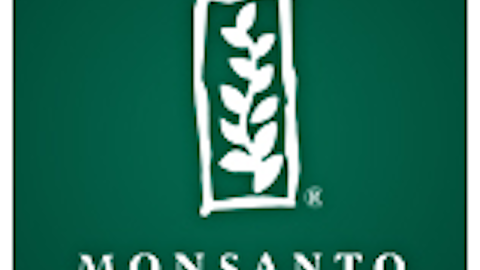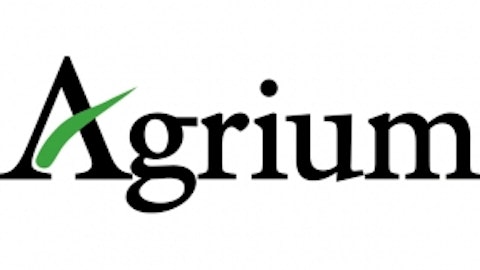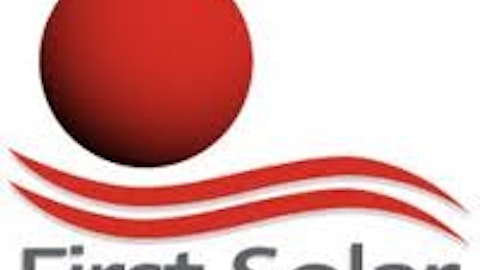Generally speaking, I believe that uncertainties in the market are one of the best creators of investment opportunities. For example, the market was uncertain of the effects of Green Mountain Coffee’s K-Cup patents expiring, and this allowed investors to scoop up shares for around $17, or 78% less than the current price, just months later. Another example of this is Monsanto Company (NYSE:MON) who are being hit by a fresh wave of bad publicity and protests. Although the company’s shares haven’t dropped as a result, I believe their troubles are causing shares to trade at a nice discount relative to their growth and profit potential.
About Monsanto
Monsanto Company (NYSE:MON) provides agricultural solutions, including seeds, herbicides, and other products. Monsanto is the largest maker of glyphosate herbicides in the United States, which it sells under its Roundup brand name; however, the Roundup line of products only accounts for about 10% of Monsanto Company (NYSE:MON)’s revenue.
Most of the company’s money is made from their seed products, many of which are genetically modified to be resistant to herbicides, particularly glyphosate, which the company produces. Other seeds made by the company are modified to produce an insecticidal protein, which the company has produced in potato, maize, soybean, and cotton seeds. Last year Monsanto Company (NYSE:MON) was the world’s largest supplier of seeds, and they sell 4,000 distinct varieties according to their website.
Monsanto Company (NYSE:MON) is developing and producing “next-generation seeds,” which are forecast to be one of the major drivers of growth going forward, as they bring higher profit margins. The company’s international business is also beginning to take off, especially in South America. Revenues are projected to grow by 12% this year, and combined with the expected higher margins, should translate to very nice earnings growth.
Because of this, the company trades at a relatively high P/E of 21.7 times TTM earnings, but I think this valuation is more than fair. The company is expected to earn $4.60 this year, rising to $5.29 and $6.01 in 2014 and 2015 respectively, due to the combination of revenue growth and high margins mentioned earlier. This translates to a 3-year average forward earnings growth rate of about 17.6%, which more than justifies the valuation. Also worthy of consideration is Monsanto Company (NYSE:MON)’s excellent balance sheet which features, among other things, $4.8 billion in cash and equivalents and just over $2 billion in debt.
March Against Monsanto
The latest in a long string of bad publicity for the company was the “March Against Monsanto Company (NYSE:MON)” which took place on May 25 and was a grassroots movement to protest against Monsanto and genetically modified organisms (GMOs). The protests took place in over 400 cities around the world and had at least 200,000 participants.
The movement began as a result of the defeat of California Proposition 37 which would have required labeling of genetically engineered food products. What escalated the efforts was the passage of the Farmer Assurance Provision, which is referred to by critics as the “Monsanto Protection Act” which essentially allows growers to continue to cultivate allegedly unsafe crops while the legal process is underway.
No Stranger to Trouble
Monsanto is no stranger to being in court due to its practices, both as plaintiff and defendant. As defendant, Monsanto has been the target of a steady stream of lawsuits over the past three decades. For example, from 1984 to 1987, Monsanto was the defendant in the longest civil trial in U.S. history when a group of plaintiffs claimed to have been poisoned by the company’s dioxin chemicals after a train accident. Most recently, one of the company’s herbicide-resistant wheats that was not yet approved was discovered growing on a farm in Oregon, and this is currently playing itself out in the legal system.
Alternatives
If Monsanto’s troubles are more than you want to have hanging over your portfolio, some of the other agricultural-chemical companies do a better job of staying out of the spotlight.
Potash
Potash Corp./Saskatchewan (USA) (NYSE:POT), a Canadian company, is the world’s largest fertilizer company by capacity. The nature of the business (no genetic engineering, relatively environmentally-friendly practices) has kept public opinion of the company largely positive over the years.
Potash offers investors an excellent dividend yield (about 3.4%) and a reasonable P/E of 17 times TTM earnings, which are projected to grow at just over 9.1% going forward. Not quite as exciting as Monsanto’s projections, but less risky. Also, the trend toward healthier eating in North America could prove to be a positive catalyst for fertilizer manufacturers such as Potash and a negative catalyst for makers of genetically altered foods, like Monsanto’s.
Syngenta
Syngenta AG (ADR) (NYSE:SYT) is a Switzerland-based company that produces herbicides, insecticides, seed care products, and more. While the company has faced some legal action in the past over some of its products, particularly herbicides, it is nothing compared to Monsanto’s legal battles. In fact, in 2011 Syngenta was recognized by the Dow Jones Sustainability Index as one of the world’s best performing chemical companies in the world based on economic, social, and environmental performance.
Syngenta trades for about 19.5 times earnings, and pays a pretty healthy dividend yield of 2.54%. The company is projected to grow its earnings at around a 12% rate going forward, and may be the more environmentally-responsible investment in the seed and chemical space.
Summary
While Monsanto may end up providing the best long-term gains of the group, there is almost always one legal issue or another that threatens to derail the company’s growth momentum. If you would prefer not to take such a risk, or just prefer to invest more environmentally responsible, either of the other two companies listed would make a great alternative.
The article Lots of Potential, Both Positive And Negative originally appeared on Fool.com and is written by Matthew Frankel.
Matthew Frankel has no position in any stocks mentioned. The Motley Fool has no position in any of the stocks mentioned. Matthew is a member of The Motley Fool Blog Network — entries represent the personal opinion of the blogger and are not formally edited.
Copyright © 1995 – 2013 The Motley Fool, LLC. All rights reserved. The Motley Fool has a disclosure policy.




